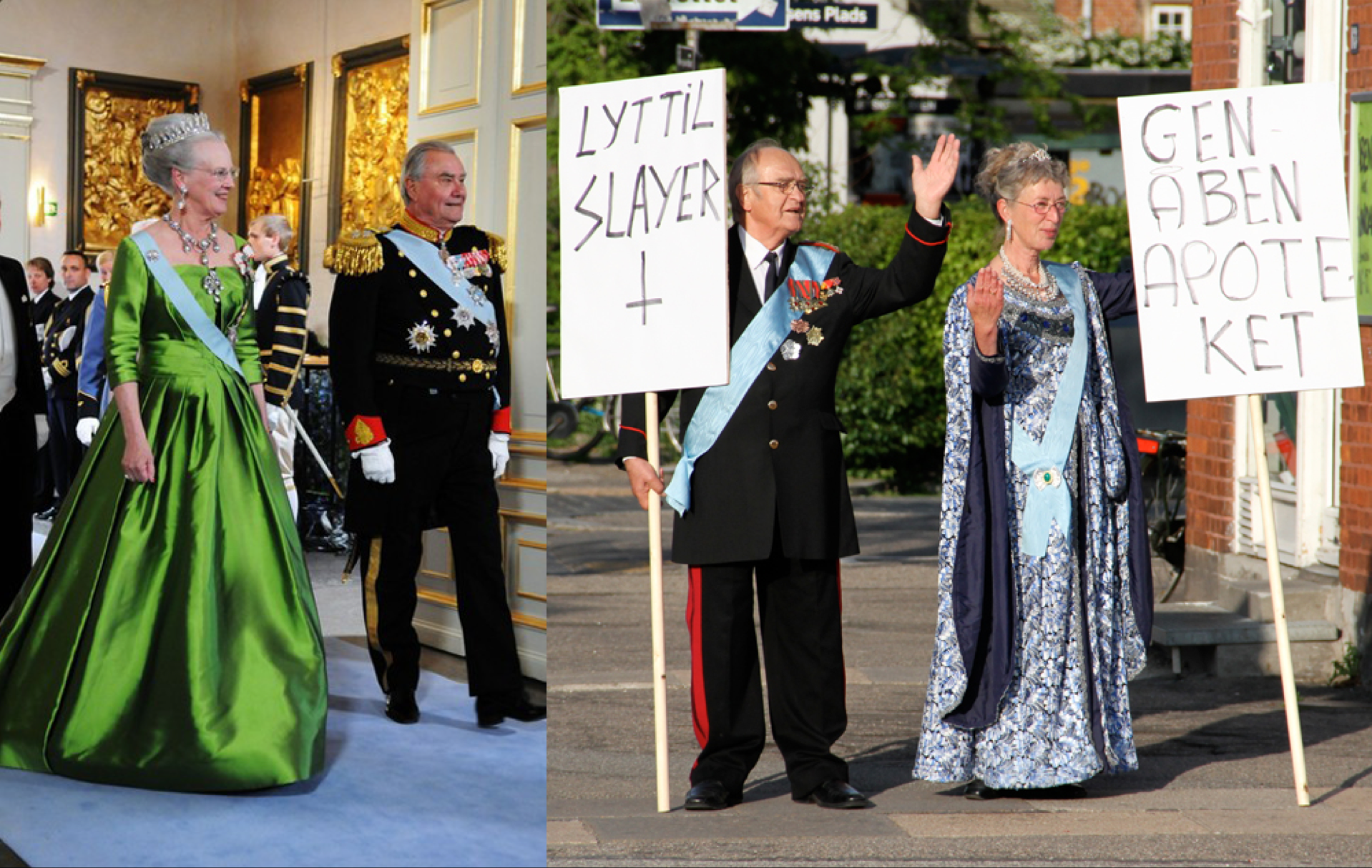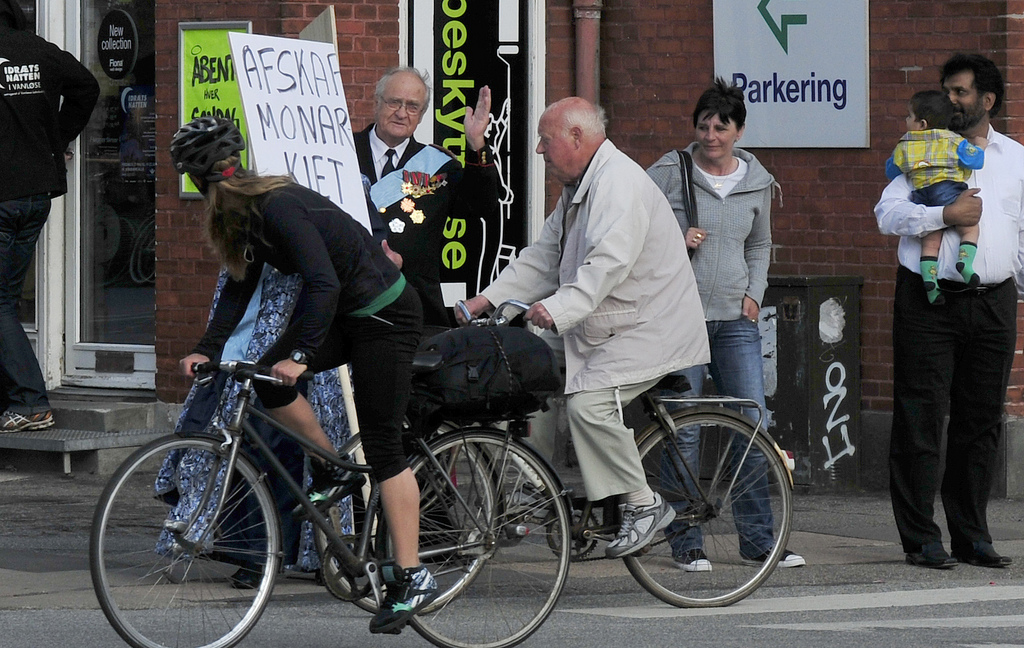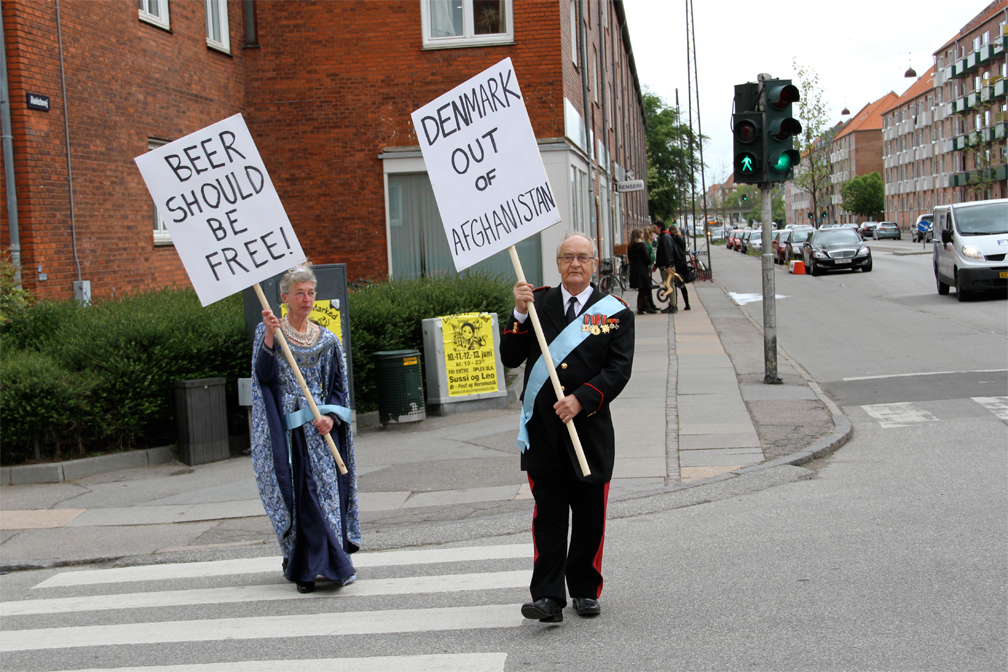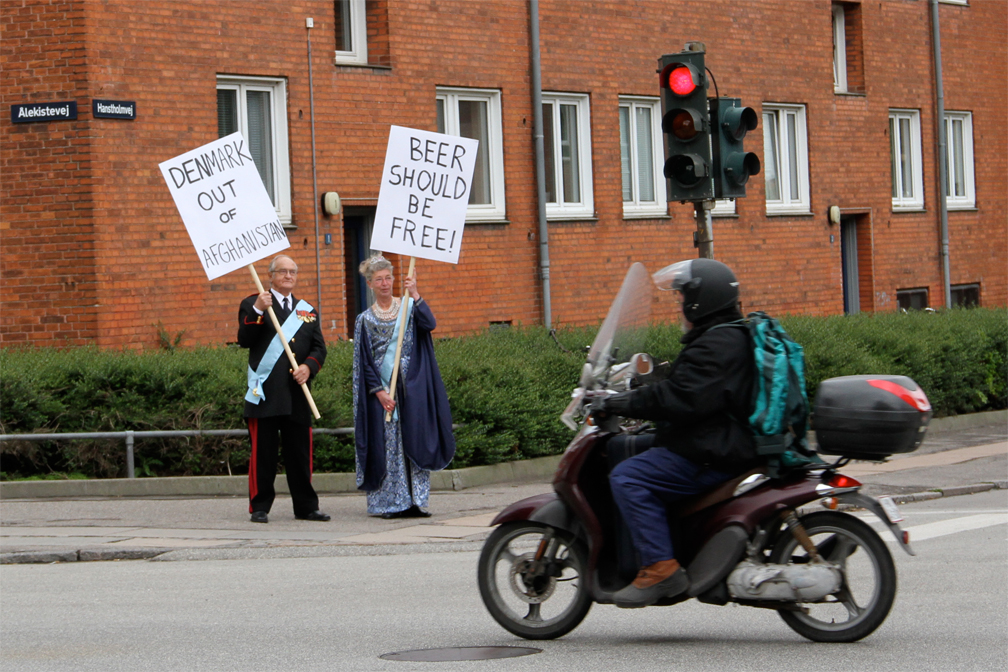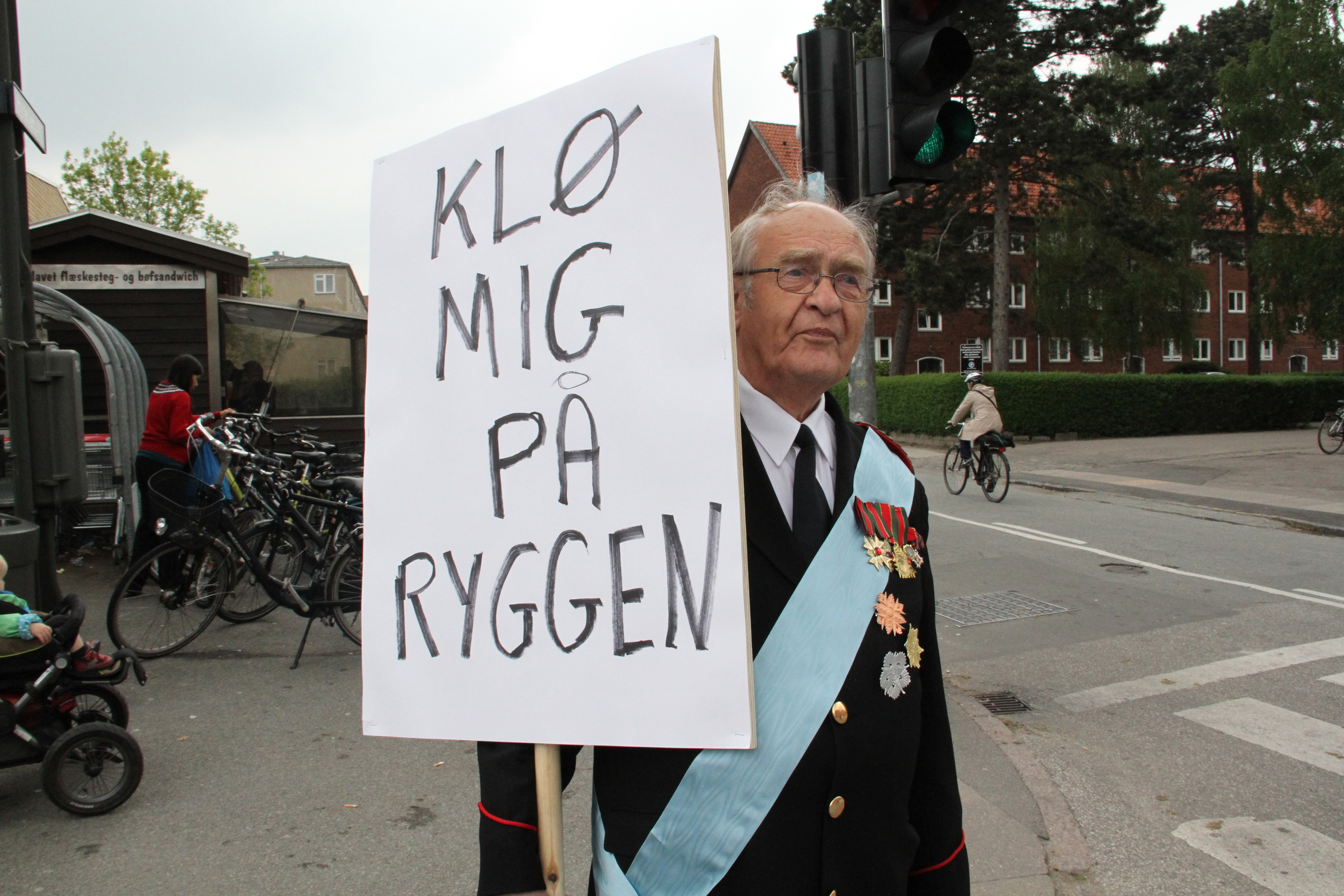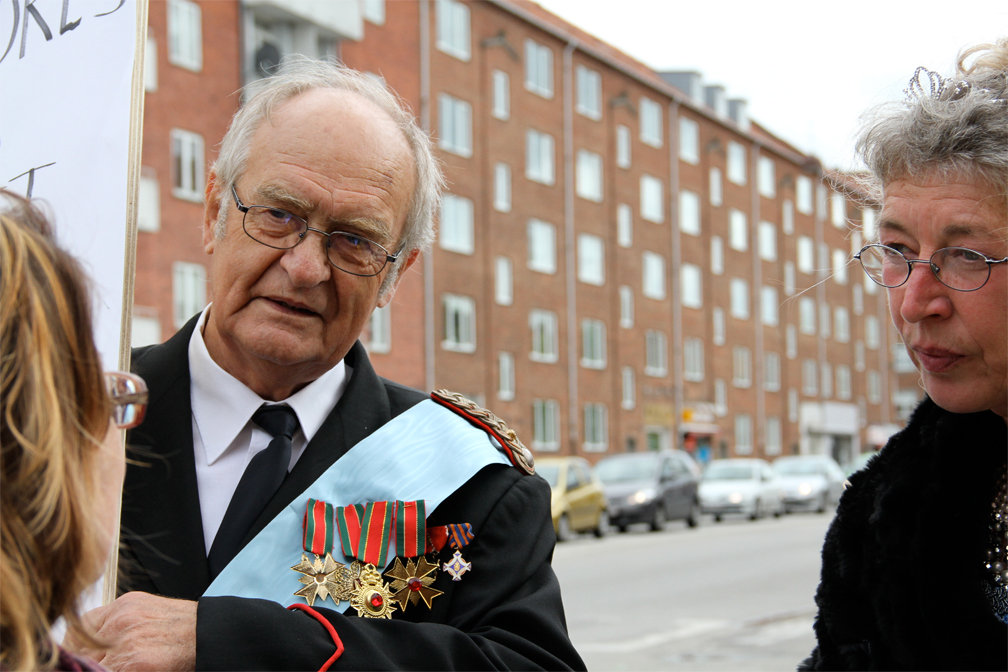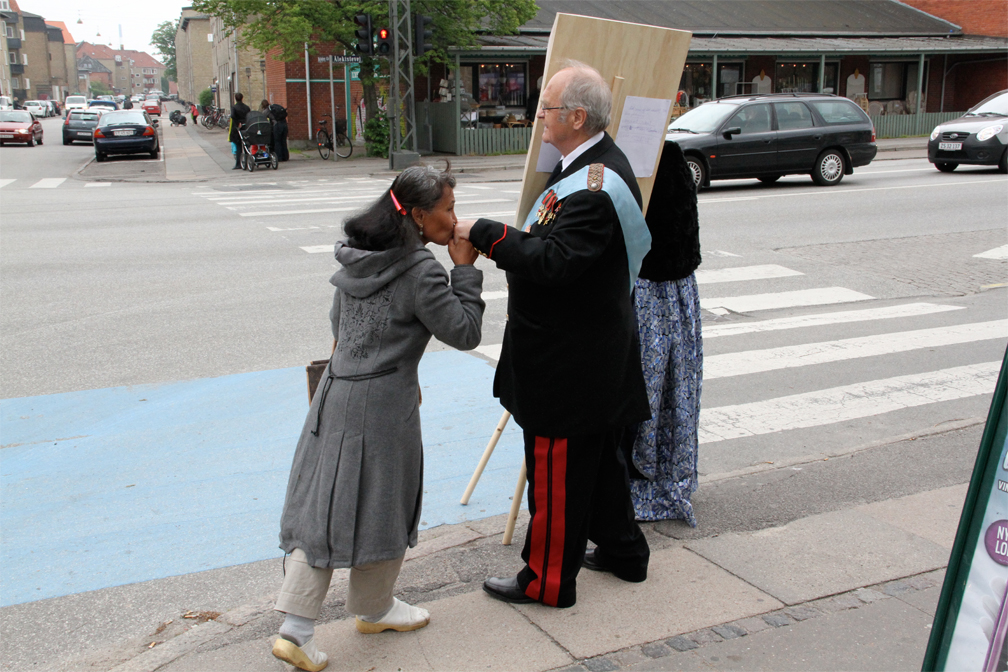Royal Danish Protesters
Copenhagen, Denmark, 2011
The Royal Danish Protesters was a daily performance over three weeks in which actors who look like the Danish Queen and Prince Consort walk through a busy district of Copenhagen carrying protest signs broadcasting the complaints or opinions of any Danish citizen who approached them. The project was designed to shift power relations, as the Queen and Prince were recast from their role as aloof figureheads into utilitarian public servants giving voice to the populous.
Collaboration with Ben Kinsley
Danish Queen played by: Mette Jensen
Danish Prince Consort played by: Hans Greve
Curated by: Hiedi Hove and Jens Axel Beck
-----------
**Excerpt from interview between the artists and Louise Trier & Marie Bruun Yde:
How would you describe your project Danish Royal Protesters for the exhibition Lokal Global Plan?
Our project will take the form of a daily performance spanning three weeks between May 17 and June 5. Actors dressed in formal attire to look like the Danish Queen and Prince Consort will walk along Ålekistevej Street in the Vanløse district of Copenhagen and hold protest signs for any Danish citizen who has a complaint. Everyone is invited to participate, though we expect the real voice of the project to come from the residents of this particular neighborhood. We are interesting in finding a unique form of broadcasting one way in which any city or district identifies itself through its grievances, both big and small. As Americans, the fact that Denmark has a royal family that lives a lavish tax-supported life is a remarkable and curious spectacle. The project casts the Royals as public servants giving voice to daily members of the populous. Also the project will give pause to the constant flow of traffic that moves up and down Ålekistevej street, a place where many live but few seem to stop. Anyone will be able to participate in the project by locating the look-alike royalty and submitting their protest. The Queen or Prince Consort will then publicly carry their message for several hours along Ålekistevej. Protest statements could take the form of a personal complaint, national debate, global fear, whimsical declaration, absurdist rant, private desire, etc.
Why are you interesting in finding a unique form of broadcasting one way in which any city or district identifies itself?
We are interested in using the social power that is afforded to the Queen and Prince in Danish society as a kind of megaphone for regular citizens. In this way the power relations are shifted, as the Queen and Prince are recast from their role as aloof fantasy figures into utilitarian public servants. This act, in and of itself, questions who has voice in a society and why certain voices are louder than others. And this is what we want to do: to create a situation where ordinary citizens and their life is highlighted over the concerns of figureheads and politicians. That is also why we prefer not to edit the complaints and messages coming in. Furthermore, we would like the performance to reflect the neighborhood at Ålekistevej. There are a lot of ways of looking at a city, or even a neighborhood, and the lens you use to view that place changes the way you will see it. In this project we are using the lens of complaint and looking at the big and small things that people would like to see change. The medium and context of broadcasting through the Queen and Prince inherently changes and charges the message. Also, using the form of the traditional "protester with sign" is a very specific approach which keeps the message local (as opposed to using social media on the internet for example). In this way we hope to focus the conversation to this neighborhood. By having the Danish Royals present citizens' protest, the statements automatically get magnified through their social authority. And maybe the negative complaints turn into something more positive or constructive, because you experience them in a more serious and personal way.
What are the challenges and advantages of making a site-specific art project for a place and a culture you were not familiar with compared to working in your own region?
While definitely challenging, it is sometimes nice to work in a completely unfamiliar place. It allows you to experience the world around you with a fresh perspective - to see it with a fresh set of eyes. When you become acclimated to your environment this is often a difficult place to return, so entering a foreign space allows you to see the mundane, everyday acts of life with a new appreciation. Everything is new to you and in many ways this is the type of experience you would want to evoke in any viewer of the work you make. The nature of being an artist, even in your own city, is to be an outsider - someone who works within the seams of society and therefore is able to move fluidly between different situations almost like a voyeur. Certainly there is a history of writers claiming this perspective and I think it applies to artists as well. The challenges of working outside of your home base is that you don't fully know the culture and social dynamics of the place you are entering. This however can happen even in your home town, where once a project is initiated, the response to it often reveals values and opinions that you might previously have been unaware of. But either way you have a social responsibility. Our intention is to stir things up, but not irresponsibly, so we have to adjust to how the context and the project play against and with each other. With this project (and all of our work) we are trying to create something that is simultaneously site-specific and universal. It teases forth ideas that people are always carrying with them as they walk the streets and in this way reflects the local environment and its residents in a framework that one can use in other places as well.
What were the reactions of the neighborhood?
We didn't know if people would participate or how the actors would play their role. This kind of protesting is very common in the US, but definitely not in Denmark, so would the performance be rejected or accepted? Fortunately, it has turned out that the locals are very fond of the performance. There have been no problems in terms of participation. Every day the royal couple receive and present about 12 different statements each day, which comprises both very political and serious complaints as well as personal and local declarations.
Participation seems to be a significant part of your work. Why do you prefer to work with participation in your art practice?
Our main focus is not really on participation in itself but more on creating a new and interesting situation in a specific context. Usually the context is the starting point for developing a project. A context is a social space and physical space at the same time, and with our projects we create a wired space or void that challenges the context. It is interesting how you can influence daily routines and draw people into the situations we create. Sometimes it can even be more powerful when people don't think of the projects in terms of art because there is always the risk that this will function as impediment to their direct experience of the work as simply a strange and perhaps poetic occurrence within their daily life.
Does participation have a certain potential? Or does art in general have a potential? In this project as well as other projects (e.g. Jon Rubin's Conflict Kitchen), conflicts, even war, is an important part of the narrative or framework. Can art solve conflicts?
Participation and art are two different things. Certainly participation is essential to revolutions and real political and social change, both good and bad. Art in general has potential for many things, but because of the still incredibly narrow definition of art in the contemporary art world, and the even smaller audience that it engages with, art is still primarily relegated to speaking about the world theoretically from a distance. This is a very privileged, yet disengaged position, perhaps analogous the role of the Royal family in society fantastic, beautiful, idealistic, yet ultimately removed. This outsider position of art is usually pretty bad at solving anything, although it is often very effective in highlighting and getting people to think about conflicts in a way they are not used to. Certainly this shift of consciousness might lead further down the road to actual change, but that is always debatable.
